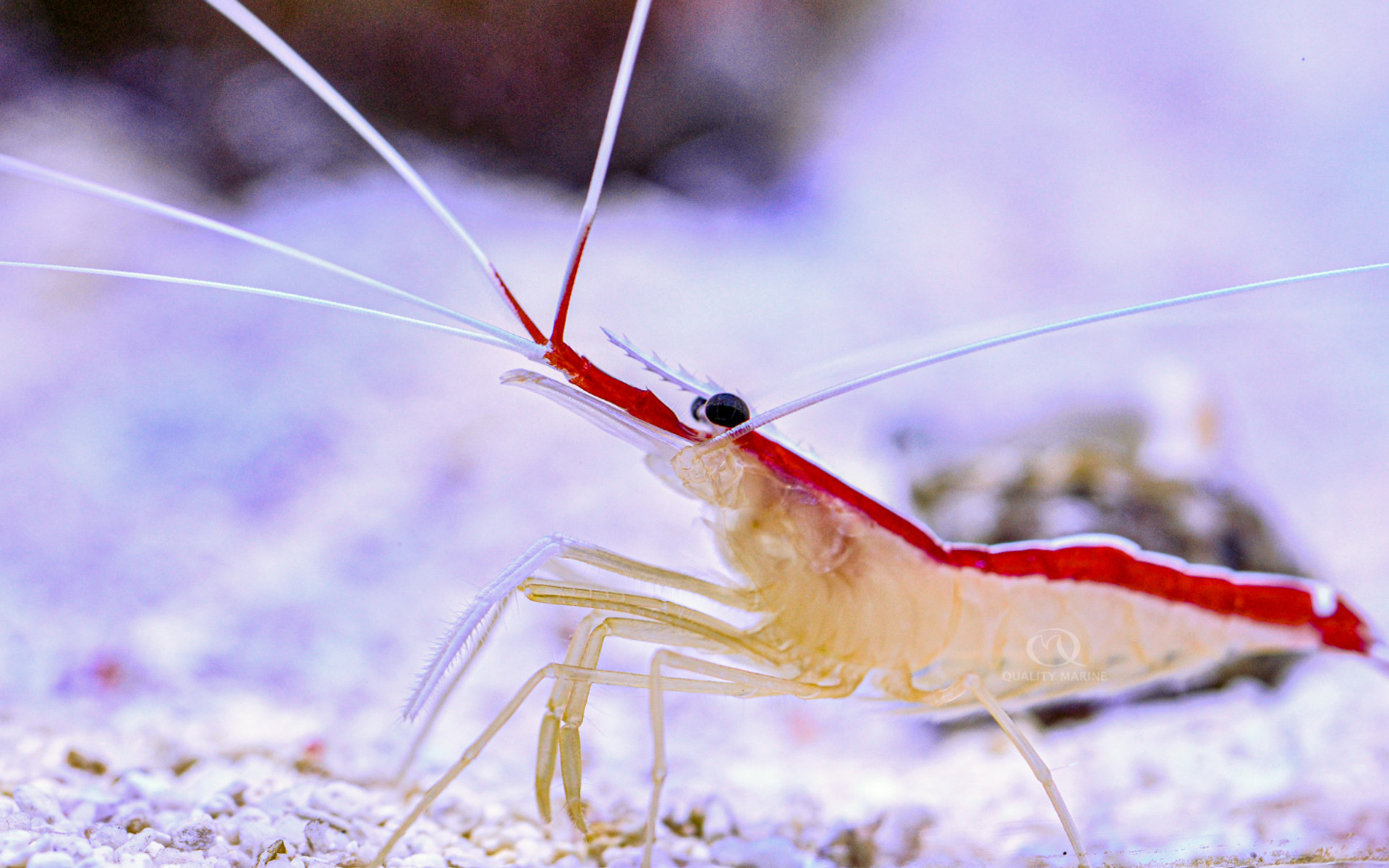The Kind of Skunk You Want

Lysmata amboinensis has become an iconic aquarium inhabitant over the decades, and as such has earned itself a few common names over the time. It is most often referred to as the “Skunk Cleaner Shrimp,” but is also frequently called “Pacific Cleaner Shrimp,” “Red Skunk Shrimp” and occasionally “Doctor Shrimp.” They are found on just about every tropical reef and rubble environment in the Pacific and Indian Oceans and into the Red Sea. They are usually found in pairs in less than 120 feet of water or so, where they will set up swim up “cleaning stations” where fish will sometimes line up for their services. The Cleaner Shrimp have a back and forth dance they do to let their customer fish know they are open for business! Lymsata amboinensis have a maximum size of just under three inches, but look much larger with their grand, shockingly white antennae. While average life span in the wild is much shorter, they can live three to five years in captivity!
Skunk Cleaner Shrimp are fascinating in that they are “simultaneous hermaphrodites.” Somewhat simplified, it means that a pair will take turns being either male or female. Every molt, they switch (a process called “Staggered Synchronization”) and thus over their lifespan, both shrimp will produce and carry eggs, and both shrimp will fertilize eggs! Wild! As long as the aquarium has stable conditions, adequate calcium / alkalinity for molting and enough food for general vitality, Lysmata amboinensis will carry this out in the home aquarium up to twice a month. Whichever shrimp is the female can release up to carry up to 2000 eggs! Sadly, the larvae are nearly impossible to raise for home aquarists. The mating behavior is fascinating, and will supply extra nutritious food for many things in the aquarium. However, the larval development stage takes up to 150 days, and has only been accomplished a few times outside of laboratory conditions.
Keeping Skunk Cleaner Shrimp in the home aquarium is very straightforward. Their wild pairing behavior carries over into the aquarium, and this is the best way to keep these shrimp. They are very peaceful with just about everything, with the sole exception of other Skunk Shrimp beyond the pair in situations where there isn't adequate space for multiple pairs. In aquariums that have a 72 inch footprint or larger, a second pair could be possible as long as their was adequate rockwork for the pairs to not interact. They get along well with peppermint shrimp (Lysmata wurdemanni), usually not noticing them at all. Blood Shrimp (L debelius) are more risky to mix species wise as they can be more territorial. We suggest a minimum tank size of 40 gallons, with larger always being better. Aquarium conditions are pretty standard for any hobbyist used to keeping invertebrates. Temps in the mid to upper 70s, super low nutrient levels, stable parameters, and NO copper treatments. The only other things you need to think about is tank mates. As cleaners, Skunks are very bold, and will clean the mouth of fish that could easily consume them. Occasionally, those fish will break the truce and eat them. While you can usually keep cleaners with just about anything, be warned that if a fish is big enough to eat them, they may.
A question we field a lot here is “are the reef safe?” And the short answer is yes, Lysmata amboinensis is a very good bet for keeping in the reef aquarium. If well fed, they are very unlikely to bother corals, clams or anemones of any type; they have been known to steal meaty food from anything they can if they are hungry. The types of larger meals that many LPS corals and anemones like are also very much appreciated by the Skunk Cleaners. We've found it best to feed them their own meaty morsels before trying to feed larger meaty items to other, slower eating aquarium inhabitants. They will greedily eat fresh/frozen morsels like silversides, chopped prawns, and mussels etc. They only need to be fed these types of meals weekly or so. Over time, you'll get a good sense of how much they eat and get better at sizing their meals.
Most of you reading this are interested in the positive effects of having a cleaner shrimp in your display. As a pure cleaner shrimp, Skunks are easily the most effective at removing parasites and dead skin among the common aquarium cleaners. Your fish will line up for the cleaners for years, and the shrimp will service them hundreds of times over this span. An important, but lesser known fact about all cleaner shrimp, but very specifically about Lysmata amboinensis is that they are also voracious predators of a variety of aquarium pests in the pest's egg and larval stages.
For those of you interested in keeping any Cleaner Shrimp, Lysmata amboinensis should be your first choice. They are fascinating to watch, ridiculously easy to keep, and beneficial to your aquarium in several ways. Their peaceful nature lends to housing them in a wide variety of displays. Contact your LFS about getting you a pair of Skunk Cleaners from Quality Marine today!